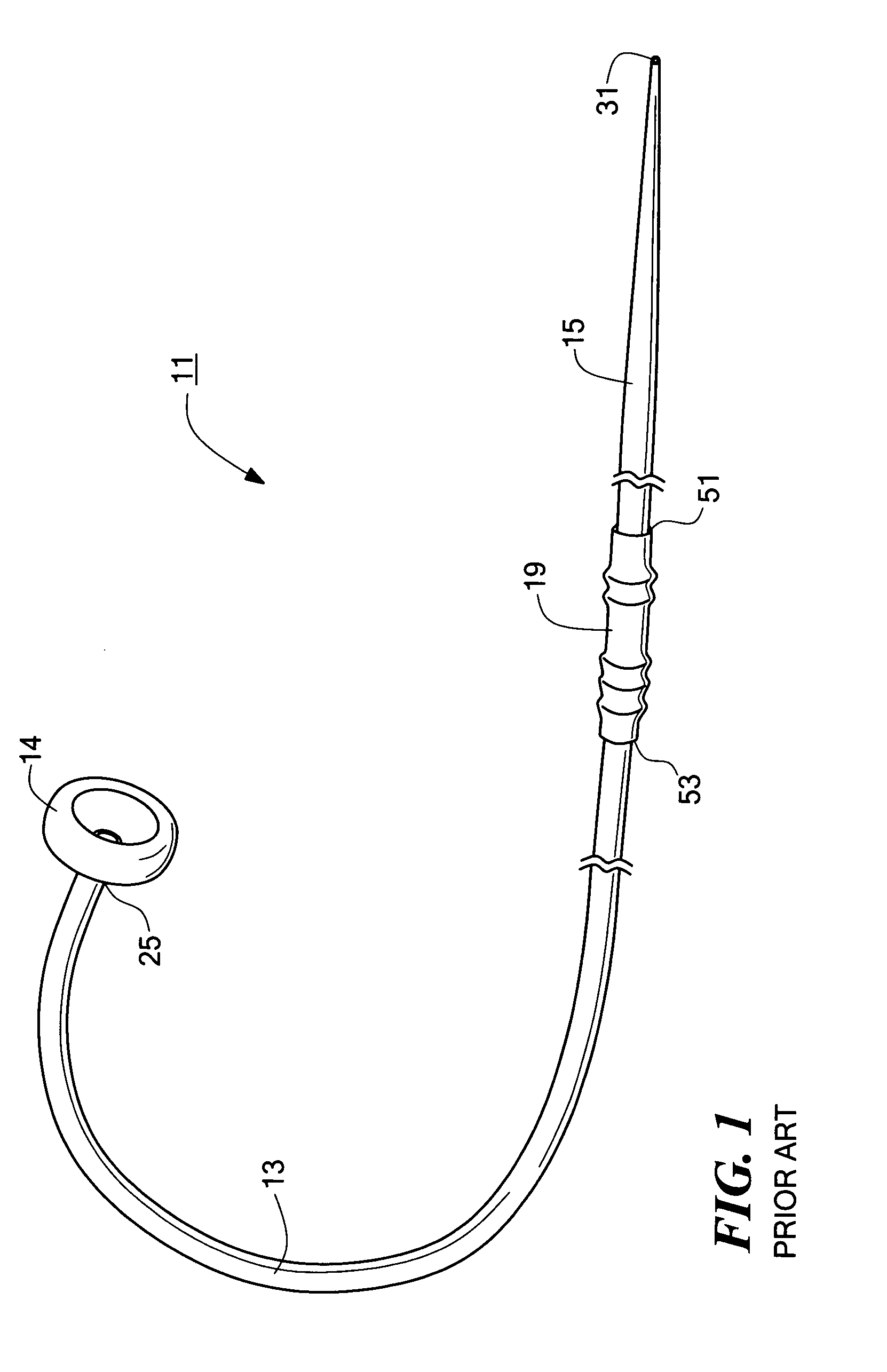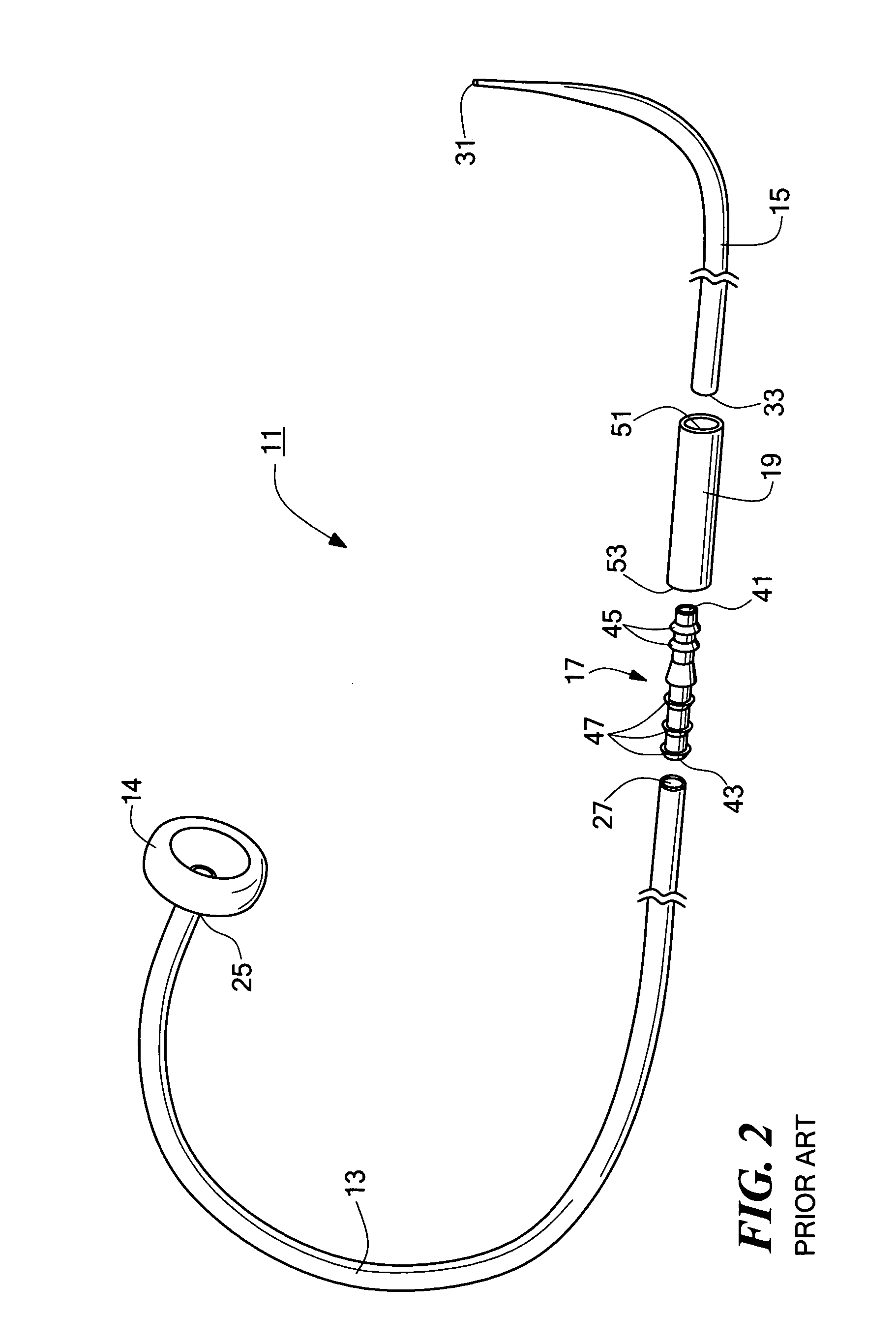Connector for use with a medical catheter and medical catheter assembly
a technology for connecting devices and medical catheters, which is applied in the field of medical catheters, can solve problems such as unsuitable long-term, unsatisfactory long-term, and inability to take food and/or medications transorally
- Summary
- Abstract
- Description
- Claims
- Application Information
AI Technical Summary
Problems solved by technology
Method used
Image
Examples
first embodiment
[0052]Referring now to FIG. 4, there is shown a fragmentary, side view, broken away in part, of a medical catheter assembly constructed according to teachings of the present invention and adapted for percutaneous endoscopic implantation in a patient using the push method, said medical catheter assembly being represented generally by reference numeral 101.
[0053]Assembly 101, which is shown prior to use on a patient, is similar in many respects to assembly 11, assembly 101 likewise comprising a gastrostomy feeding tube 13, an internal bolster 14 and a dilator 15. Assembly 101 differs from assembly 11, however, in that assembly 101 does not include the combination of connector 17 and tubing 19 for interconnecting tube 13 and dilator 15. Instead, assembly 101 comprises, as a means for interconnecting tube 13 and dilator 15, the combination of a connector 103, a length of silicone tubing 105 mounted within connector 103, and a quantity of silicone glue 107 (e.g., Nusil's MED 4860) applie...
second embodiment
[0065]Referring now to FIG. 8, there is shown a fragmentary, side view, broken away in part, of a medical catheter assembly constructed according to teachings of the present invention and adapted for percutaneous endoscopic implantation in a patient using the push method, said medical catheter assembly being represented generally by reference numeral 301.
[0066]Assembly 301, which is shown prior to use on a patient, is similar in most respects to assembly 101, the principal difference between the two assemblies being that assembly 301 comprises a connector 303, instead of connector 103.
[0067]Referring now to FIGS. 9(a) through 9(d), there are shown various isolated views of connector 303. Connector 303, which is a unitary member preferably made of molded plastic, is shaped to include a rear portion 310 and a front portion 315. Rear portion 310, in turn, comprises a rearward section 311 and a forward section 313. Rearward section 311, which is inserted into leading end 27 of tube 13, ...
third embodiment
[0071]Referring now to FIG. 10, there is shown a fragmentary, section view of a medical catheter assembly constructed according to the teachings of the present invention and adapted for percutaneous endoscopic implantation in a patient using the push method, said medical catheter assembly being represented generally by reference numeral 401.
[0072]Assembly 401, which is shown prior to use on a patient, is similar in many respects to assembly 101, the principal difference between the two assemblies being that assembly 401 does not include the combination of connector 103, tubing 105 and silicone glue 107 to interconnect tube 13 and dilator 15. Instead, assembly 401 comprises, as a means for interconnecting tube 13 and dilator 15, the combination of a connector 403 and a quantity of silicone glue 405 applied to connector 403 in the manner hereinafter described.
[0073]Referring now to FIGS. 11(a) through 11(d), there are shown various isolated views of connector 403. Connector 403, which...
PUM
 Login to View More
Login to View More Abstract
Description
Claims
Application Information
 Login to View More
Login to View More - R&D
- Intellectual Property
- Life Sciences
- Materials
- Tech Scout
- Unparalleled Data Quality
- Higher Quality Content
- 60% Fewer Hallucinations
Browse by: Latest US Patents, China's latest patents, Technical Efficacy Thesaurus, Application Domain, Technology Topic, Popular Technical Reports.
© 2025 PatSnap. All rights reserved.Legal|Privacy policy|Modern Slavery Act Transparency Statement|Sitemap|About US| Contact US: help@patsnap.com



